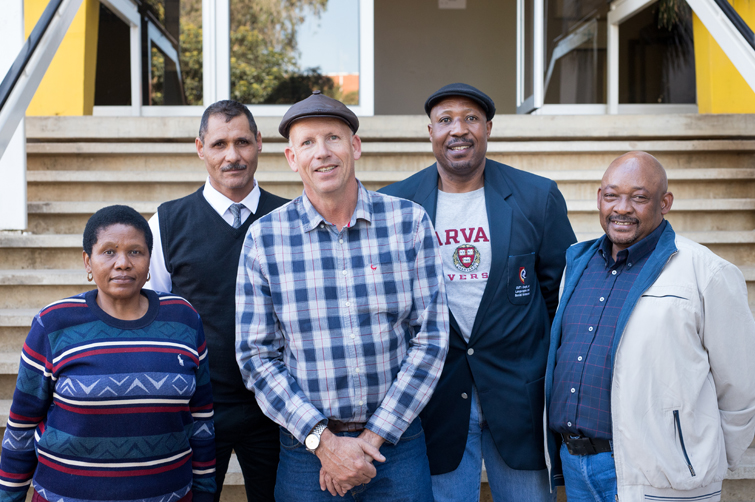Latest News Archive
Please select Category, Year, and then Month to display items
13 January 2020
|
Story Eugene Seegers
|
Photo Anja Aucamp
 Spearheading the digital expansion of the conversational Sesotho course is IDEAS Lab Director, Johann Möller (middle). With him are from the left: Prof Pule Phindane, CUT; Dr Brenton Fredericks, CUT; Bahedile Letlala, UFS Department of African Languages; and Dr Elias Malete, UFS Department of African Languages.
Spearheading the digital expansion of the conversational Sesotho course is IDEAS Lab Director, Johann Möller (middle). With him are from the left: Prof Pule Phindane, CUT; Dr Brenton Fredericks, CUT; Bahedile Letlala, UFS Department of African Languages; and Dr Elias Malete, UFS Department of African Languages.
For many years now, the UFS has been offering a one-year course in conversational Sesotho for staff members; this can then be followed up with the one-year course in advanced conversational Sesotho. The conversational Sesotho for students in the Faculty of Education was introduced in 2018 at the UFS.
The Central University of Technology (CUT) needed a conversational course for its first-year students and approached the Department of African Languages for the development of such a course. Living as we do in a multilingual country; this additional language skill opens doors and often hearts as well.
Using instructional design principles
However, the need was identified by both CUT and UFS to present this crucial information in a way that would be more appealing to digital natives as well as to those less familiar with technology. The Department of African Languages on the UFS Bloemfontein Campus, together with relevant departments from the CUT, approached the IDEAS Lab located on the UFS South Campus, since they already have a reputation for being a specialist on broadcasting and repackaging curricular content for digital presentations. The IDEAS Lab provided technical advice and built the multimedia programme, which will help the user to hear and practice phrases in Sesotho, using instructional design principles. The course will be available to both staff and students belonging to the two universities.
Room for growth
Johann Möller, Director of the IDEAS Lab, says this pilot programme will give both institutions the opportunity to test the use of multimedia for language acquisition. He adds, “Language is extremely complex, and we would like to expand this learning aid in the future.” In fact, the original design has room for growth built into it.
To keep things simple for the user and the building team, it was decided to start out with only four potential everyday scenarios where a staff member would like to speak Sesotho: Firstly, how to greet other persons from different genders; secondly, potential scenarios one might encounter in the university environment itself; thirdly, how to deal with situations at a hospital; and finally, how to use one’s language skills at a filling station.
Pronunciation is key
Each scenario contains three to four conversations that the learner can revise, along with images and audio that illustrate the situation and assist with correct pronunciation. The system does not allow the user to progress unless they have listened to the pronunciations of the sample sentences or phrases.
Further reading material and vocabulary lists are also provided, with the result that people who are using the programme can learn at their own pace. The authoring software Articulate Storyline was used to build the individual scenarios and each conversation or lesson within it. The lessons are also not dependent on an internet connection; they can be downloaded onto a flash memory drive and used offline.
Regional winner designing her way to Architectural Student of the Year Award
2016-03-09

Musa Shangase, Corobrik Commercial and Marketing Director, and Nilene van Niekerk. |
For 29 years, Corobrik has been celebrating the most outstanding architectural talent in South Africa. This year, Nilene van Niekerk – a master’s graduate of the University of the Free State (UFS) Department of Architecture – features as one of the regional winners.
Deciding on a dissertation topic, Nilene contemplated how she could use architecture as a tool to address a non-architectural contemporary problem specific to post-apartheid democratic South Africa. Her answer was born from her passion for freedom of speech. “Freedom of speech and the intimidation of journalists by the controversial Secrecy Bill were at the forefront these past few years,” Nilene says. “Although freedom of expression are generally protected practices in South Africa’s constitution, the persistent role of the government to protect state information is a substantial threat to citizens’ constitutional right of freedom of expression.”
This resulted in Nilene’s dissertation topic, Freedom of Expression Forum. This architectural concept envision a building, in the vicinity of Constitutional Hill, that symbolises protest against the Secrecy Bill. The building will provide “protection to journalists and become a pivotal point where classified information can be sent and archived. It will also establish a public space that encourages communication – all in the name of fostering the right of freedom of expression within this human rights precinct,” Nilene says.
Nilene will now go on to compete for the national title at the Corobrik Student Architect of the Year Awards in Johannesburg in May 2016.
“The project also rethinks the idea of sustainability as it focuses on how to contribute to a sustainable political future in South Africa. I believe that we as architects, especially in a third world country, should think beyond the normative boundaries of sustainability,” Nilene says.